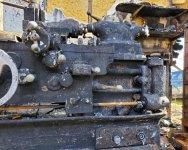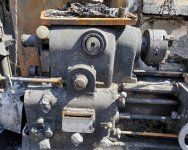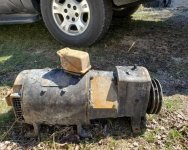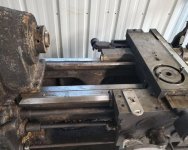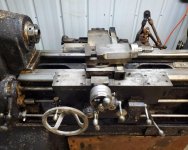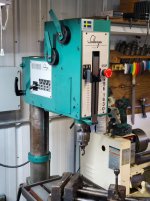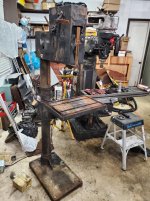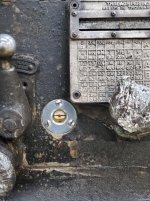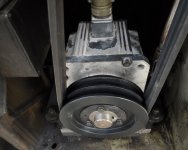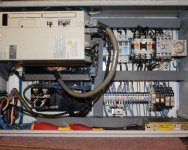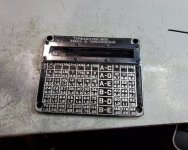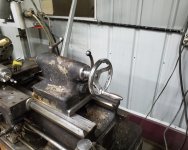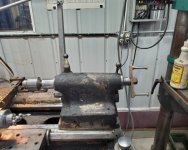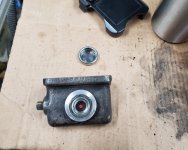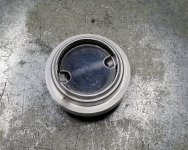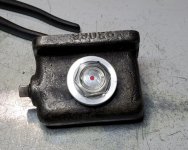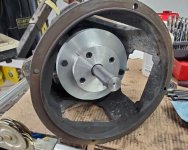Marc M.
Aluminum
- Joined
- Apr 21, 2005
- Location
- Marshalltown, IA
2 days prior to moving my equipment out of my Brother's shop and into mine it burned to the ground. I lost my Enco mill, Solberga drill press, and worst of all, my 10EE. All machines were in excellent condition, very little wear on them. It took me several years of hunting to come up with these machines, not to mention a fair bit of cash. His insurance would have covered everything so I contacted Monarch to request a quote on replacement. They said they could rebuild my machine and quoted around $63,000.00. Unfortunately my brother had lung cancer and died before the claims could be submitted. With no other recourse I drug my machine carcasses up to my place and set about repairing what I could. To add injury to insult, before he passed we were trying to get the machines moved. The Monarch slipped off a skate and while I was sticking it back under the machine, my brother slipped with the prybar resulting in the machine rolling over and crushing my left arm. Within a week he was pretty much paralyzed and I was left trying to move everything by myself with only 1 arm.
The Monarch is S/N 50294 manufactured 9-69. It has ELSR and a taper attachment. It came out of a Delco / Delphi plant in Ohio and was supposedly in an engineering modeling shop. There was a brass Delco ID tag affixed below the dataplate. The bed still had chips and misc. parts in it. I found copper, brass, aluminum, and steel chips. There was also a box in the end cabinet with a bunch of different odds and ends in it so the origin is plausible.
It had the original GE 5HP DC motor. The commutator and brushes looked like new, very little signs of wear on them. It was a modular machine but all the original electronics had been removed and an Allen Bradley 1395 DC drive retrofitted. The drive worked well although I couldn't get much over 3K RPM's out of it. I was running it off a RPC for several years without any problems until there was a brownout while it was running. It took out the main control board and I was having a problem finding a replacement for under $1200. To get it running until I could repair the drive I put a 5hp motor and VFD in it, direct drive, no back gear. I then saw Macona's AC Servo conversion and was immediately sold on it. I was able to snag a new in box Mitsubishi MR-H350A drive off Fleabay for $150 within a few months of looking. The motor was a different story. I wanted a 3.5Kw, 3K RPM servo motor, but most were only 2K. When a 3K would pop up it was hundreds, sometimes over $1000. It took about 3 years but I finally snagged one for under $200. Luckily I never had time to do the conversion and had all the servo stuff up here at the house so it was spared. The original motor and gear box were not so lucky and were in the garage when it burned down.
The Monarch is S/N 50294 manufactured 9-69. It has ELSR and a taper attachment. It came out of a Delco / Delphi plant in Ohio and was supposedly in an engineering modeling shop. There was a brass Delco ID tag affixed below the dataplate. The bed still had chips and misc. parts in it. I found copper, brass, aluminum, and steel chips. There was also a box in the end cabinet with a bunch of different odds and ends in it so the origin is plausible.
It had the original GE 5HP DC motor. The commutator and brushes looked like new, very little signs of wear on them. It was a modular machine but all the original electronics had been removed and an Allen Bradley 1395 DC drive retrofitted. The drive worked well although I couldn't get much over 3K RPM's out of it. I was running it off a RPC for several years without any problems until there was a brownout while it was running. It took out the main control board and I was having a problem finding a replacement for under $1200. To get it running until I could repair the drive I put a 5hp motor and VFD in it, direct drive, no back gear. I then saw Macona's AC Servo conversion and was immediately sold on it. I was able to snag a new in box Mitsubishi MR-H350A drive off Fleabay for $150 within a few months of looking. The motor was a different story. I wanted a 3.5Kw, 3K RPM servo motor, but most were only 2K. When a 3K would pop up it was hundreds, sometimes over $1000. It took about 3 years but I finally snagged one for under $200. Luckily I never had time to do the conversion and had all the servo stuff up here at the house so it was spared. The original motor and gear box were not so lucky and were in the garage when it burned down.


